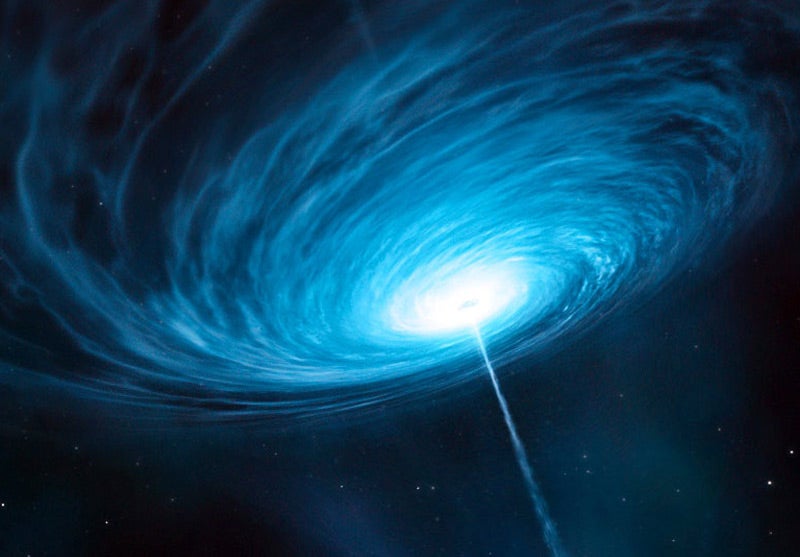Four-tunate Finding
Listen 00:06:51500,000 quasars (quasi-stellar radio sources) have been detected – including 100 binaries, two triples, and now – one quad. A quasar is a compact region in the center of a massive galaxy surrounding a central supermassive black hole.
A grouping of two or more quasars can result from a chance alignment, physical proximity, actual close physical interaction, or effects of gravity bending the light of a single quasar into two or more images. The power of quasars originates from supermassive black holes that are believed to exist at the core of all galaxies.
A Neutron Star with a magnetic personality observed just 2 trillion miles from the Milky Way’s Supermassive Black Hole core, still too far for interaction researchers think it may be caused by either starquakes or surface bombardment of charged particles trapped in twisted bundles of magnetic fields. More data needed.
Skygazers; Watch how Jupiter and Venus creep toward each other this week in the west after sunset.
-

Photo by Flickr user NASA Blueshift
Dave Heller: New observations of some of the most luminous and powerful objects in the cosmos are in turn shedding light on the variety of things to be seen in our universe. Let’s set our tuners to quasi-stellar radio sources with Derrick Pitts, chief astronomer at the Franklin Institute. And Derrick, we’re not talking about 91 FM, this is a much different bandwith.
Derrick Pitts: We’re talking about actual objects that are found in the very deepest reaches in the universe, these objects called quasars. And only recently have we been able to understand that we’re actually seeing are supermassive black holes at the cores of nascent galaxies.
Quasars are black holes?
Yes, quasars are supermassive black holes that are found at the core of almost every gigantic galaxy, it seems, in our universe.
Including our own?
Yes, including our own, so there is a supermassive black hole at the core of our galaxy as well, but the quasar part of the supermassive black hole’s life is an instance where materials crashing down onto the accretion disk and enormous amounts of x-ray radiation are blasted out as a result that makes the quasar at the core of the galaxy outshine everything in the galaxy.
Think of the accretion disk as the rim on the edge of the black hole?
Sure, if you’re looking at a plate it’s all of the rest of the circular nature of the plate except for the very center dot where the singularity of the black hole would be. And the material crashing down on to this and rotating around this singularity generates this incredible radiant energy.
But if everything falls into that hole, how can energy escape?
That’s a good question. We always think of black holes as this place where material falls in and then disappears. In fact, what does happen, is material crashes down onto the accretion disk as it rotates around due to conservation of angular momentum as it heads toward the singularity its energy level is raised to point where that material is then radiated away as energy so we can also identify jets of material that shoot out from the rotational axis of the black hole as well.
Now is the rule of thumb, one black hole per galactic costumer?
Well we would like to think that’s the case but as it turns out we may not be so certain about that because we’ve been able to identify half a million quasars around the universe already, there are probably more but those all seem to be individuals. We have been able to identify 100 that are binary, but only 2 triples have been found and only recently has a quadruplet of these objects been seen.
Binaries, triples and in this case a quad, does it imply that they are in physical proximity to each other?
Oh indeed these are, what’s typical for quasars is a distance of perhaps as much as a hundred million miles apart; that seems to be standard. In this case, these are only 700,000 miles apart, so really much closer to each other than expected and you would think of them as being a group of quasars together because of their proximity to each other. The also happen to be found in a cloud of cool hydrogen gas so that, again, makes them all part of the same group.
Now lets move on to a still mighty but relatively tiny energy source, that being a neutron star.
Yes, astronomers have discovered a neutron star with an incredibly magnetic personality, meaning that it has incredibly strong magnetic fields. It in fact appears to be a neutron star just 2 trillion miles away from the supermassive black hole of the Milky Way, our galaxy. And its made itself know because its been doling out incredible amounts of energy which seems to be very much uncharacteristic for a neutron star to do. First thought was that perhaps its because there is some sort of interaction taking place between that neutron star and the black hole but 2 trillion miles is a little bit too far away for anything really significant to be taking place so astronomers have been trying to think of an alternate method with which this energy could be generated.
Are neutron stars formed that way right out of the chute or is it a stage in the evolution of the life of the star?
Its really a stage in the evolution of the life of a star and it all depends on how much mass the star begins with. The more mass a star begins with the more likely it is going to become a neutron star. And with enough mass a star can even go beyond that and become a black hole but neutron star life in itself is really incredibly amazing. These are objects that are about 20 kilometers in diameter. They tend to be a little bit more massive than our star is so imagine something only 20 kilometers across that is more massive than our star. If you take one teaspoon full of neutron star material it can weigh 100 million tons. Now that is incredibly massive but you have to remember that we’re working with the most massive part of the nucleus of any atomic structure, the neutrons and this is just neutrons alone. But its unusual characteristics also lend it to have an incredibly tough and durable crust. Can you imagine a crust on a star? Its kind of strange but when you get to this level of physics there is a structure that can be identified as a crust that is 10 billion times more durable than steel.
Fortunately our sun is not a candidate for this trajectory.
Fortunately our sun is not a candidate for this trajectory and by the time are star gets old enough we’ll probably be long gone from here anyway.
Well let’s come back to the present time and place and given clear skies, what’s available to be seen in the night sky this week?
The main players of the spring sky have been Venus and Jupiter, Venus very bright in the West after sunset, Jupiter almost directly overhead as one observes Venus…however, what’s going to happen over the next week is we are going to see what looks like an accelerated approach of the two as they seemingly come together in the evening sky. Now that close approach of the two doesn’t happen until late June but this week we will easily be able to notice how it seems as if Jupiter is coming down toward Venus and Venus seems to be rising up toward Jupiter. As long as we have clear skies it should be a great site to see especially with a pair of binoculars.
WHYY is your source for fact-based, in-depth journalism and information. As a nonprofit organization, we rely on financial support from readers like you. Please give today.




